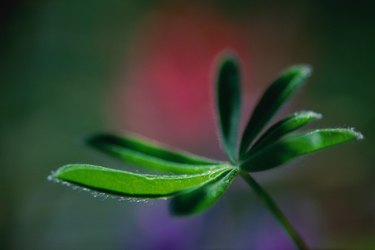
The umbrella tree (schefflera) is a tropical plant grown for its attractive, fan-shaped foliage. Reaching 8 feet or more at maturity, the umbrella tree makes a striking specimen plant. The tree grows outdoors in areas that see little or no freezing and does especially well as a houseplant. Occasionally, the tree experiences problems with disease.
Damping-Off
Video of the Day
Damping-off (Pythium splendens) is a disease that tends to attack umbrella tree seedlings and small trees. Lesions form on the tree's stem at the soil line, causing the plant to wilt and collapse. A moldy growth may also cover the plant in humid weather. Damping-off is sometimes mistaken for insect damage or overwatering. There is no cure for damping-off. Discard infected umbrella trees.
Video of the Day
Leaf Blight
Leaf blight (Pseudomonas cichorii) is a bacterial disease that tends to infect the margins of umbrella tree leaves. Water-soaked spots form on the foliage that enlarge and blacken. The condition causes excessive leaf drop and overall weakening of the plant.
Bactericides exist but tend to be ineffective. Prevention is your best defense for leaf blight. The disease thrives in moist conditions, so keep schefflera foliage dry. Remove and dispose of infected leaves immediately to prevent the spread of the disease.
Leaf Spot
Leaf spot is a fungal disease. Alternaria leaf spot (Alternaria panax) causes brown to black spots on foliage and stems. Eventually, leaves drop, leaving bare stems on the umbrella plant. Phytophthora leaf spot (Phytophthora parasitica) causes spotting on the lower leaves closest to the ground first.
Treat leaf spot disease with the appropriate fungicide. Prevent further infection by keeping foliage dry.
Oedema
The umbrella tree is susceptible to oedema. This condition occurs when the schefflera's roots take up water more quickly than the plant can absorb the moisture. The overabundance of water leads to hard tan, white or brown blisters on the umbrella tree foliage. Leaves yellow, wilt and drop, and the tree becomes weak.
Prevent oedema by growing umbrella trees in an area with good air circulation, and avoid overwatering. Let the top 2 to 3 inches of the soil dry before irrigating.
Powdery Mildew
Powdery mildew is a fungal infection that causes a powdery white or gray film on the umbrella tree foliage. The condition begins as small, powdery spots that enlarge. Powdery mildew is most common during humid weather. The disease causes stunted, malformed leaves that yellow and drop. The fungus feeds on plant tissue, removing nutrients and causing overall umbrella tree decline.
Treat powdery mildew on umbrella trees with the appropriate fungicide. Also remove and discard infected leaves, and improve air circulation around the tree.
- Clemson University Cooperative Extension; Schefflera; Karen Russ, et al.; March 1999
- University of Florida; Schefflera Production Guide; R.T. Poole, et al.
- Cornell University Plant Disease Diagnostic Clinic: Schefflera Disease Factsheets
- Cornell University Plant Disease Diagnostic Clinic: Oedema; October 1999
- Cornell University Plant Disease Diagnostic Clinic; Powdery Mildew; March 2009
- University of Illinois Extension; Damping-Off and Root Rots of Houseplants and Garden Flowers; February 1988
- Colorado State University Extension; Schefflera; October 2010